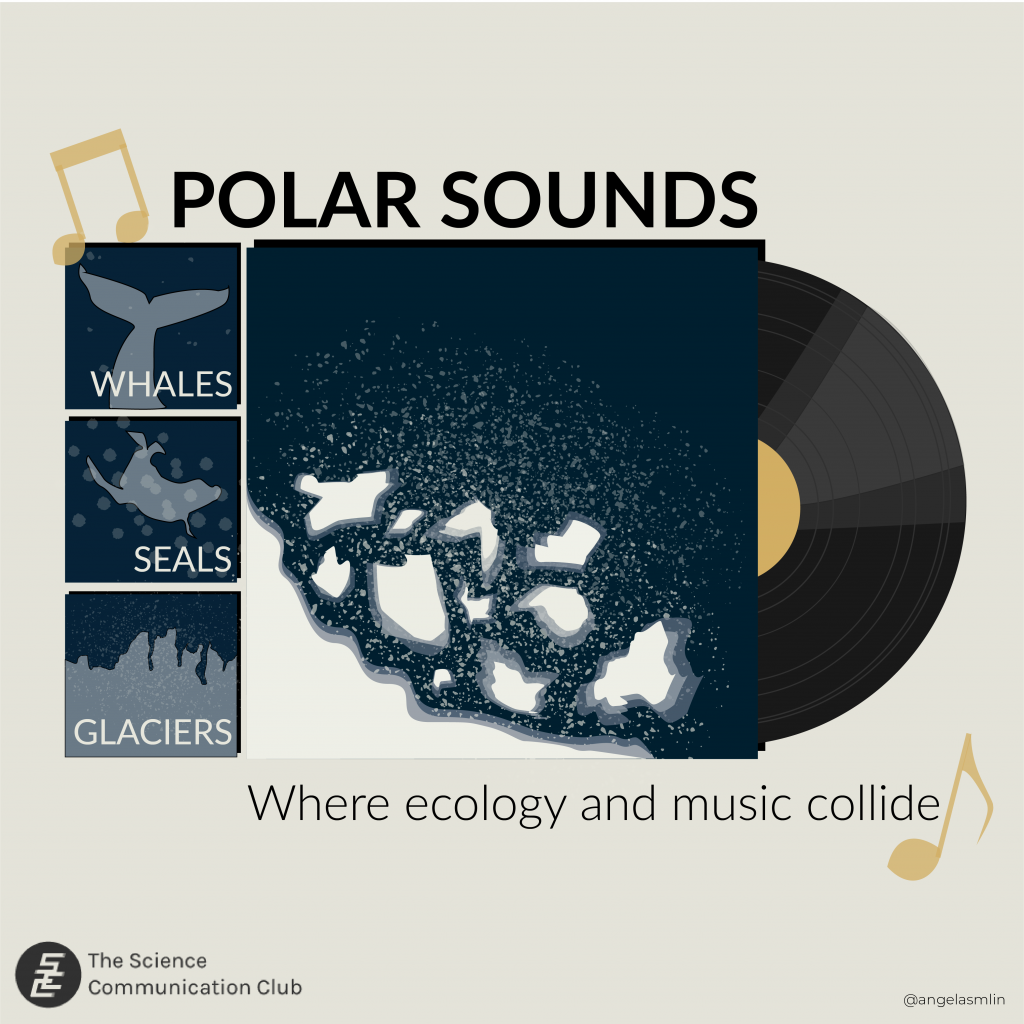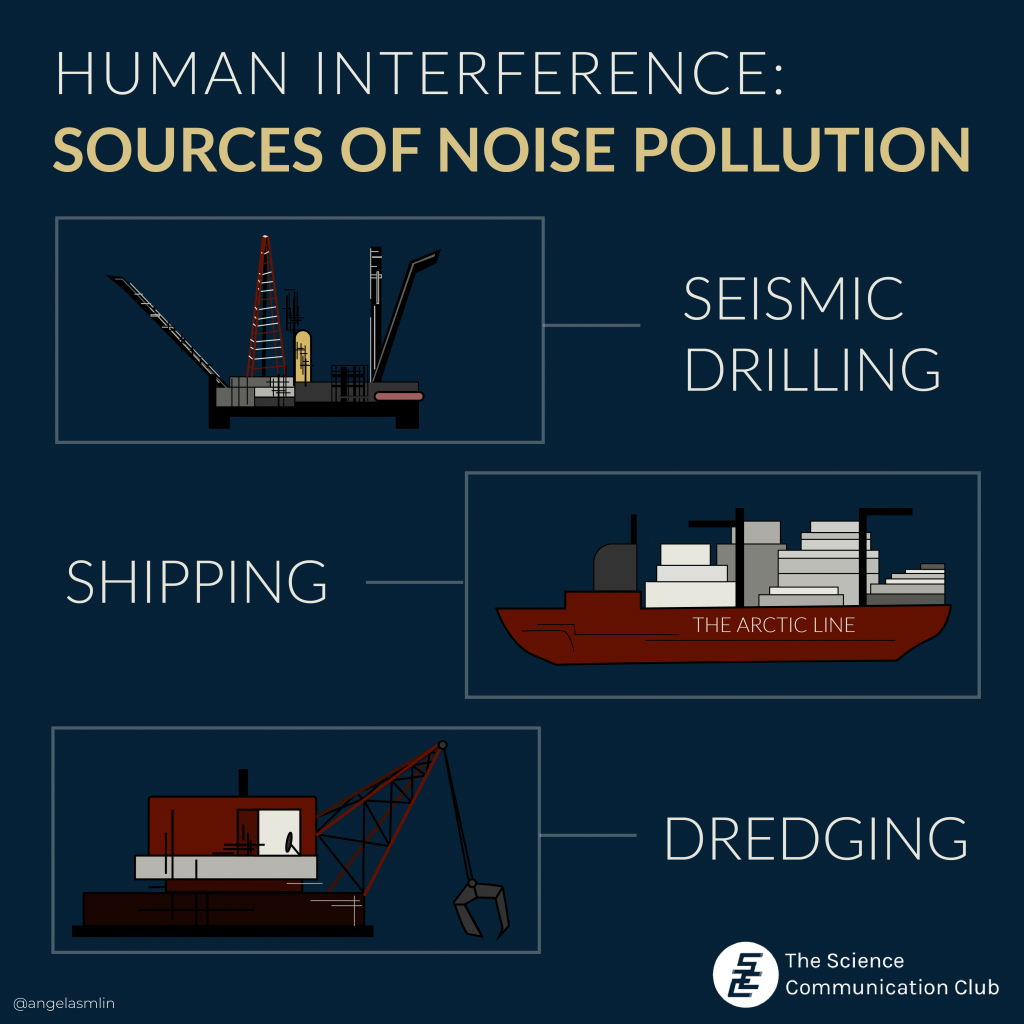
Written by Angie Lo
Illustrated by Angela Lin
Orcas and Ross seals accompanied by a violin? A bowhead whale’s call remixed as a love song? Colliding icebergs combined with synths and electric guitars? These are all songs that feature in Polar Sounds, a newly released album from the sound project Cities and Memory.1
Cities and Memory’s work involves taking field recordings from around the world and remixing them into new songs. This allows listeners to explore new reimaginings and interpretations of sounds and noises of all kinds.2 Polar Sounds, their latest album, is a unique collaboration between musicians and polar and marine scientists. Taking the waters of the Arctic and Antarctic as its inspiration, the album remixes recordings from underwater microphones placed there by researchers.1
Attached to floats with scientific instruments, these underwater microphones recorded the sounds of wildlife, water and ice, and human activity over the span of two years.3 The researchers, who come from both the Helmholtz Institute for Functional Marine Biodiversity and the Alfred Wegener Institute, find such recordings extremely valuable.1 Sight isn’t always a possible observation method in the polar depths, and audio recordings provide an alternative information source on many aspects of Arctic wildlife, ranging from breeding habits to the effects of human interference.1 But with their collaboration, scientists and musicians alike are hoping that the impacts of these recordings will reach even further.
Dr. Geraint Rhys Whittaker, who works for both the Helmholtz and Alfred Wegener institutes, hopes that listening to the recordings will encourage people to think more about the polar oceans; more particularly, the ways they are threatened by negative human interference.3 The recordings picked up a lot of noise pollution, including noise from seismic drilling, which has been found to negatively affect animal life.3 Dr. Whittaker is hopeful that the recordings will emphasize the need for laws reducing noise from shipping and dredging, which is also damaging to marine life.3

Dr. Ilse von Opzeeland, from the Alfred Wegener Institute, is optimistic that Polar Sounds’ musical remixes will inspire reflection from a wider audience. “A ‘translation’ through art breathes new life into our scientific data that goes beyond a traditional publication or policy paper by making it accessible to non-scientists,” she says.3
Stuart Fowkes, the founder of Cities and Memory, states that Polar Sounds is meant to “draw attention to a fascinating but rapidly changing environment, and encourages us to think about ways to preserve it for future generations.”3 Many musicians involved in the album have commented on their desire to evoke reflection on environmental degradation and biodiversity loss through their compositions. Composer Claire Pearson’s “Briefest encounter” is a remixed recording of the Ross seal, telling the story of a deep-sea diver who is in awe at the seal’s beauty but also feels sadness at its uncertain future.1 Composer Ana Mora’s piece, “Reflections on the seals”, incorporates a poem reflecting on the warming of the poles, but also elicits hope of reversing the damage that has been done.1
You can listen to both the original recordings and their musical remixes for free on the Polar Sounds webpage. For each song, comments from both researchers and musicians are included, providing information on both the original recording and the reimagined song. First on the playlist is Sean Ou Tim’s “Majestic mammalia”, a reworking of humpback whale sounds musically illustrating the whale’s migratory journeys. The whale calls blend in perfectly with a melody that’s graceful yet full of energy, which not only creates but also immerses the listener in a sense of wondrous movement. In another beautiful piece, Baying Ridges’ “Sea creatures”, recordings of Ross seals and orcas (plus other sea-like sounds) come together orchestra-style to create a wild-sounding, haunting melody.
But those are just a few of the plethora of thoughtfully-crafted compositions in the album. With remixed songs from over 100 musicians on a variety of ecological themes,1 Polar Sounds is an album inviting much reflection– which hopefully will galvanize into future tangible action.
Sources
- Polar Sounds. Cities and Memory. [accessed 2023 Feb 18]. https://citiesandmemory.com/polar-sounds/
- What is Cities and Memory? Cities and Memory. [accessed 2023 Feb 18]. https://citiesandmemory.com/what-is-cities-and-memory-about/
- Rannard G. The Antarctic and Arctic sounds rarely heard before. BBC News. 2023 Feb 6 [accessed 2023 Feb 18]. https://www.bbc.co.uk/news/science-environment-64514258